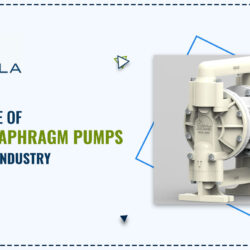A Diaphragm Pump, also known as a membrane pump, is a positive displacement pump that allows industrial users to standardize on a pump type that is suited for a wide range of fluids. The sole requirement is a supply of compressed air. Moreover, these pumps are utilized for transferring fluids with high, low, or medium viscosities, as well as fluids containing a high solids content.
Additionally, these pumps can withstand a wide range of harsh chemicals, including acids, because they may be built with a variety of body materials and diaphragms. This blog explores the components of a diaphragm pump and its working.
The Primary Components Of A Diaphragm Pump
It is made up of only a few major components, which are as follows:
- Non-return (suction and discharge) valves
- The pumping chamber
- Diaphragm
- Suction hose manifold
- Discharge spout
Moreover, these pumps are normally operated pneumatically, but they can also be operated electrically or mechanically. Electric motors are required for electrically powered pumps, whereas pneumatically operated pumps require an air distribution valve.
Working Mechanism of Diaphragm Pump
These pumps work by creating a temporary chamber with two flexible diaphragms that reciprocate back and forth to draw fluid in and out of the pump. The diaphragms function as a wall of separation, between the fluid and the air. The following is the particular working principle:
First stroke: The two diaphragms are joined by a shaft via the center part, which houses the air valve. The air valve’s function is to direct compressed air to the rear of diaphragm number one, which causes it to move away from the center portion. The first diaphragm creates a press stroke, which moves liquid out of the pump. Diaphragm number two is executing a suction stroke at the same time. Because the air behind diaphragm number two is being pushed out into the atmosphere, atmospheric pressure is pushing the liquid to the suction side. When the suction ball valve is pushed away from its seat, fluid can flow through it and into the liquid chamber.
Second stroke: When the pressurized diaphragm number one reaches the end of its stroke, the air valve switches the flow of air from diaphragm number one to the rear of diaphragm number two. As a result of the compressed air pushing diaphragm number two away from the center block, diaphragm number one is drawn toward the center block. The discharge ball valve is pushed out of its seat in pump chamber number two, but not in pump chamber number one. When the stroke is finished, the air valve returns the air to the rear of diaphragm number one, and the cycle is restarted.
In conclusion
Diaphragm pumps are particularly efficient since they can handle fluids with low, medium, or high viscosities. You can rely on our pumps with double diaphragm regardless of your application needs; low or high flow, and harsh or delicate performance. Nirmala Pumps, as a leading manufacturer in this field, offers the best solutions for your toughest pumping difficulties. Additionally, we guarantee that our products like the Double Diaphragm Pump ensure that your systems function properly.

Nirmala Pumps & Equipments
Nirmala Pumps & Equipments is an Indian company that manufactures and supplies pump systems, valves, strainers, and pneumatic pumps since 1989. We provide services to different industries, both domestically and internationally, such as citrus, distilling, wastewater treatment, and petroleum.








